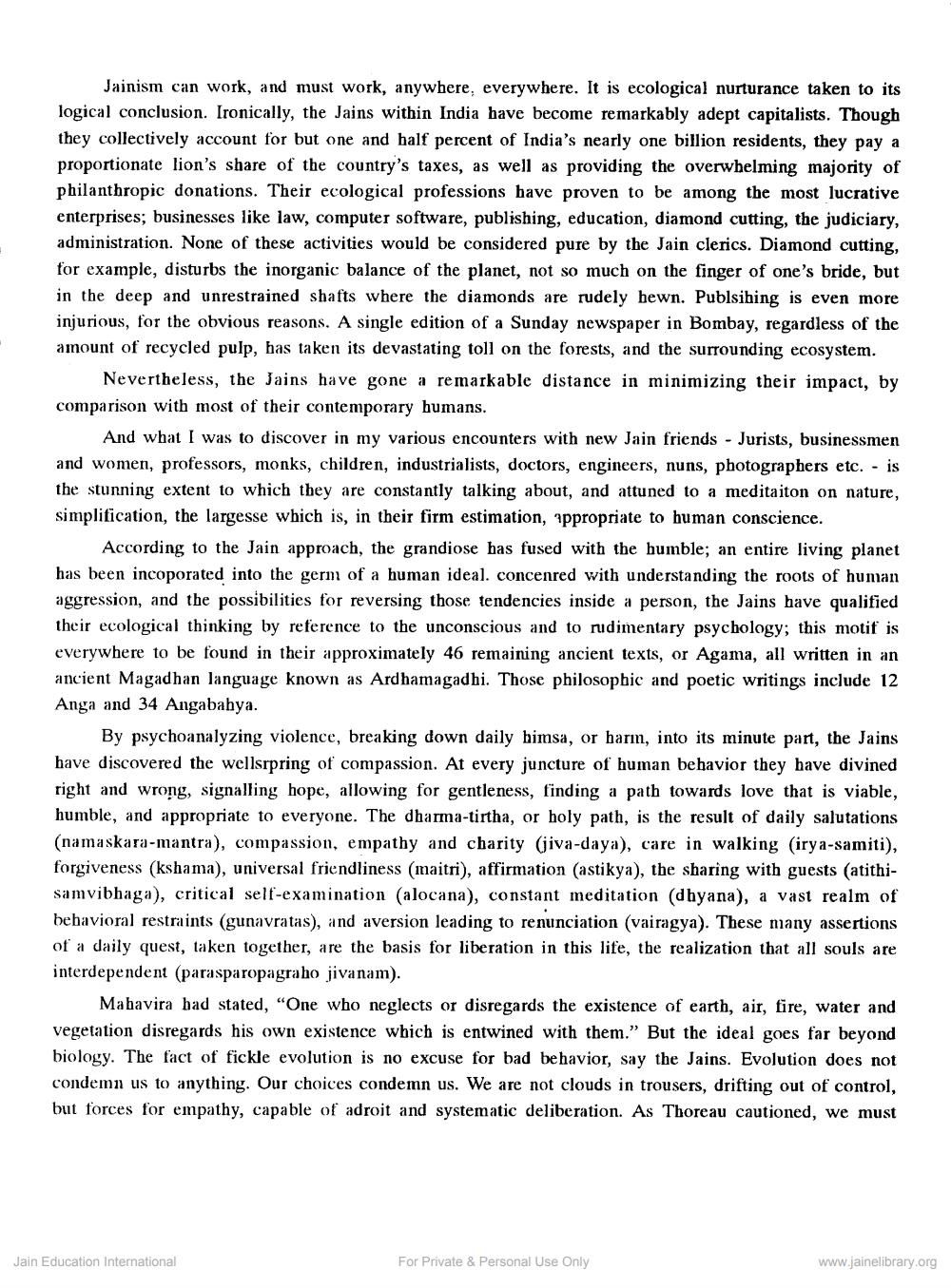________________
Jainism can work, and must work, anywhere, everywhere. It is ecological nurturance taken to its logical conclusion. Ironically, the Jains within India have become remarkably adept capitalists. Though they collectively account for but one and half percent of India's nearly one billion residents, they pay a proportionate lion's share of the country's taxes, as well as providing the overwhelming majority of philanthropic donations. Their ecological professions have proven to be among the most lucrative enterprises; businesses like law, computer software, publishing, education, diamond cutting, the judiciary, administration. None of these activities would be considered pure by the Jain clerics. Diamond cutting, for example, disturbs the inorganic balance of the planet, not so much on the finger of one's bride, but in the deep and unrestrained shafts where the diamonds are rudely hewn. Publsihing is even more injurious, for the obvious reasons. A single edition of a Sunday newspaper in Bombay, regardless of the amount of recycled pulp, has taken its devastating toll on the forests, and the surrounding ecosystem.
Nevertheless, the Jains have gone a remarkable distance in minimizing their impact, by comparison with most of their contemporary humans.
And what I was to discover in my various encounters with new Jain friends - Jurists, businessmen and women, professors, monks, children, industrialists, doctors, engineers, nuns, photographers etc. is the stunning extent to which they are constantly talking about, and attuned to a meditaiton on nature, simplification, the largesse which is, in their firm estimation, appropriate to human conscience.
According to the Jain approach, the grandiose has fused with the humble; an entire living planet has been incoporated into the germ of a human ideal. concenred with understanding the roots of human aggression, and the possibilities for reversing those tendencies inside a person, the Jains have qualified their ecological thinking by reference to the unconscious and to rudimentary psychology; this motif is everywhere to be found in their approximately 46 remaining ancient texts, or Agama, all written in an ancient Magadhan language known as Ardhamagadhi. Those philosophic and poetic writings include 12 Anga and 34 Angababya.
By psychoanalyzing violence, breaking down daily himsa, or harm, into its minute part, the Jains have discovered the wellsrpring of compassion. At every juncture of human behavior they have divined right and wrong, signalling hope, allowing for gentleness, finding a path towards love that is viable, humble, and appropriate to everyone. The dharma-tirtha, or holy path, is the result of daily salutations (namaskara-mantra), compassion, empathy and charity (jiva-daya), care in walking (irya-samiti), forgiveness (kshama), universal friendliness (maitri), affirmation (astikya), the sharing with guests (atithisamvibhaga), critical self-examination (alocana), constant meditation (dhyana), a vast realm of behavioral restraints (gunavratas), and aversion leading to renunciation (vairagya). These many assertions of a daily quest, taken together, are the basis for liberation in this life, the realization that all souls are interdependent (parasparopagrabo jivanam).
Mahavira had stated, "One who neglects or disregards the existence of earth, air, fire, water and vegetation disregards his own existence which is entwined with them." But the ideal goes far beyond biology. The fact of fickle evolution is no excuse for bad behavior, say the Jains. Evolution does not condemn us to anything. Our choices condemn us. We are not clouds in trousers, drifting out of control, but forces for empathy, capable of adroit and systematic deliberation. As Thoreau cautioned, we must
Jain Education International
For Private & Personal Use Only
www.jainelibrary.org




